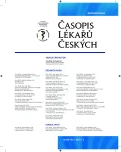Cardiovascular abnormalities in liver cirrhosis
Authors:
Jana Šmalcová; Radan Brůha
Authors‘ workplace:
IV. interní klinika 1. LF UK a VFN, Praha
Published in:
Čas. Lék. čes. 2013; 152: 123-128
Category:
Review Article
Overview
Cirrhosis of the liver is associated with a number of cardiovascular abnormalities. Characteristic features in cirrhotic patients include hyperdynamic splanchnic as well as systemic circulation. This is related to arterial vasodilation leading to central hypovolaemia, sodium retention and increased intravascular volume. As a result of these changes, signs of systolic and diastolic dysfunction of the heart with electrophysiological correlates can develop; this condition is referred to as cirrhotic cardiomyopathy. Since early diagnosis may be difficult, undiscovered cardiovascular changes can manifest in cardiac failure. It can negatively affect morbidity and mortality of what is already a serious condition such as cirrhosis, and what is a good enough reason for continued research.
Keywords:
cardiomyopathy – hyperdynamic circulation – cirrhosis of the liver – electrophysiological abnormalities – cardiac failure
Sources
1. Wong F. Cirrhotic cardiomyopathy. Hepatology International 2009; 3(1): 294–304.
2. Lee SS. Cardiac abnormalities in liver cirrhosis. The western journal of medicine. 1989; 151: 530–535.
3. Møller S, Henriksen JH. Cardiovascular complications of cirrhosis. Gut 2008; 57(2): 268–278.
4. Henriksen JH, Møller S. Cardiac and systemic haemodynamic complications of liver cirrhosis. Scandinavian Cardiovascular Journal 2009; 43(4): 218–225.
5. Timoh T, Protano MA, Wagman G, Bloom M, Vittorio TJ. A perspective on cirrhotic cardiomyopathy. Transplantation Proceedings 2011; 43(5): 1649–1653.
6. Myers RP, Lee SS. Cirrhotic cardiomyopathy and liver transplantation. Liver transplantation 2000; 6(Suppl S1): S44–S52.
7. Baik SK, Lee SS. Cirrhotic cardiomyopathy: causes and consequences. Journal of Gastroenterology and Hepatology 2004; 19: 185–190.
8. Piano MR, Schwertz DW. Alcoholic heart disease: a review. Heart Lung. 1994; 23: 3–17.
9. Ma Z, Lee SS. Cirrhotic cardiomyopathy: Getting to the heart of the matter. Hepatology 1996; 24(2): 451–459.
10. Vallance P, Moncada S. Hyperdynamic circulation in cirrhosis: a role for nitric oxide? Lancet 1991; 337(8744): 776–778.
11. Møller S. Cirrhotic cardiomyopathy: a pathophysiological review of circulatory dysfunction in liver disease. Heart 2002; 87(1): 9–15.
12. Ruiz-del-Arbol L, Monescillo A, Arocena C, Valer P, Ginès P,Moreira V, Milicua JM, Jiménez W, Arroyo V. Circulatory function and hepatorenal syndrome in cirrhosis. Hepatology 2005; 42(2): 439–447.
13. Gould L, Shariff M, Zahir M, Di Lieto M. Cardiac hemodynamics in alcoholic patients with chronic liver disease and a presystolic gallop. The journal of clinical investigation 1969; 48: 860–868.
14. Inglés AC, Hernández I, García-Estaň J, Quesada T, Carbonell LF. Limited cardiac preload reserve in conscious cirrhotic rats. American journal of physiology 1991; 260, H1912–1917.
15. Krag A, Bendtsen F, Henriksen JH, Møller S. Cardiac effects of terlipressin in cirrhosis. Unmasking a cirrhotic cardiomyopathy. Journal of Hepatology 2007; 46(Suppl S): 96.
16. Møller S, Henriksen JH. Cardiovascular dysfunction in cirrhosis: pathophysiological evidence of a cirrhotic cardiomyopathy. Scandinavian Journal of Gastroenterology 2001; 36(8): 785–794.
17. Zardi EM, Abbate A, Zardi DM, Dobrina A, Margiotta D, van Tassel BW, Afeltra A, Sanyal AJ. Cirrhotic cardiomyopathy. Journal of the American College of Cardiology 2010; 56(7): 539–549.
18. Fields NG., Baoxue Y, Leenen FHH. Sodium-induced cardiac hypertrophy. Cardiac sympathetic activity versus volume load. Circulation research 1991; 68: 745–755.
19. Torregrosa MS, Aguadé L, Segura R, Gónzalez A, Evangelista A, Castell J, Margarit C, Esteban R, Guardia J, Genescà J. Cardiac alterations in cirrhosis: reversibility after liver transplantation. Journal of Hepatology 2005; 42: 68–74.
20. Rabie RN, Cazzaniga M, Salerno F, Wong F. The use of E/A ratio as a predictor of outcome in cirrhotic patients treated with trans-jugular intrahepatic portosystemic shunt. The American Journal of Gastroenterology 2009; 104(10): 2458–2466.
21. Hongqun L, Lee SS. Cardiopulmonary dysfunction in cirrhosis. Journal of Gastroenterology and Hepatology 1999; 14: 600–608.
22. Henriksen JH, Fuglsang S, Bendtsen F, Christensen E. Dyssynchronous electrical and mechanical systole in patients with cirrhosis. Journal of Hepatology 2002; 36(4): 513–520.
23. Henriksen JH, Gotze JP, Christensen E, Bendtsen F, Møller S. Increased circulating pro-brain natriuretic peptide in patients with cirrhosis. Gut 2003; 52: 1511–1517.
24. Ward CA, Ma Z, Lee SS, Giles WR. Potassium currents in atrial and ventricular myocytes from a rat model of cirrhosis. American journal of physiology: Gastrointestinal and Liver Physiology 1997; 273(2): G537–G544.
25. Rosmawati M, Forsey PR, Davies MK. Effect of liver transplantation on QT interval prolongation and autonomic dysfunction in end-stage liver disease. Hepatology 1997; 23(5): 1128–1134.
26. Møller S, Henriksen JH. Cirrhotic cardiomyopathy. Journal of Hepa-tology 2010; 53(1): 179–190.
27. Mikulic E, Munoz C, Puntoni LE, Lebrec D. Hemodynamic effects of dobutamine in patients with alcoholic cirrhosis. Clinical Pharmacology & Therapeutics 1983; 34(1): 56–59.
28. Ripoll C, Catalina MV, Yotti R, Olmedilla L, Pérez-Peña J, Lo Iacono O,Rincón D, García-Fernández MA, Bermejo J, Bañares R. Cardiac dysfunction during liver transplantation: Incidence and Preoperative Predictors. Transplantation 2008; 85(12): 1766–1772.
Labels
Addictology Allergology and clinical immunology Angiology Audiology Clinical biochemistry Dermatology & STDs Paediatric gastroenterology Paediatric surgery Paediatric cardiology Paediatric neurology Paediatric ENT Paediatric psychiatry Paediatric rheumatology Diabetology Pharmacy Vascular surgery Pain management Dental HygienistArticle was published in
Journal of Czech Physicians

Most read in this issue
- Cardiovascular abnormalities in liver cirrhosis
- Sobering-up stations in the Czech Republic in the context of analogous models of care for acute intoxications in Europe
- Experience with personalised medicine with respect to disability assessment in patients suffering from mental and behavioural disorders
